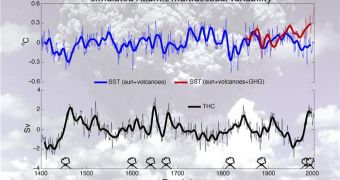According to recent discoveries, it would appear that the North Atlantic climate patterns are heavily influenced by volcanic eruptions, and even solar intensity.
The new work appears in the latest issue of the esteemed scientific journal Nature Geoscience.
The data also suggests that variations in these events act as metronomes for temperatures in these areas. The investigation that led to these results was conducted by experts in Norway.
Using a tool known as the Bergen Climate Model, researchers at the Bjerknes Center for Climate Research looked at climate data spanning back more than 600 years.
They compared the results of applying the Model with the evolution of observed temperatures, and were able to establish a connection between the number and intensity of volcanic eruptions, and also the intensity of the Sun, and variations in local temperature.
Until now, it was widely believed that the changes occurring in the North Atlantic climate were a direct result of changes taking place in the large-scale ocean circulation.
But this common view is now being challenged by this study. In other words, the research team found that the previous correlations only held when the Model did not include volcanic eruptions and solar activity.
When these two factors were introduced in the equation, the situation changed, and their influence on the statistical data immediately became obvious.
Volcanoes were find to act both directly and indirectly on the region's climate. In addition to producing cooling due to the massive amounts of gas they deposit into the atmosphere, that block out sunlight, the eruptions also impact the atmosphere and oceanic circulation directly.
The new data could in the near future be used to develop more accurate models for predicting how the North Atlantic's climate looks the way it does.
Its largest influences could also be determined in more exquisite detail, researchers believe. The team behind the work was led by expert Odd Helge Ottera, who is also the lead author of the Nature Geoscience study.
An extremely important finding is the fact that the Model cannot account for the warming in the area during the 20th century using these data alone.
This means that other influences, such as pollution and other human activities, also contributed to the temperature swings. The finding supports the climate change and global warming models, AlphaGalileo reports.

 14 DAY TRIAL //
14 DAY TRIAL //